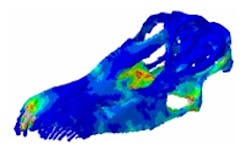CT skull scanning reveals eating habits of dinosaurs
A team of international researchers led by Bristol University (Bristol, UK) and the Natural History Museum (London, UK) has used CT scans and finite element analysis to show that Diplodocus -- one of the largest dinosaurs ever discovered -- had a skull adapted to strip leaves from tree branches.
The Diplodocus is a sauropod from the Jurassic Period and one of the longest animals to have lived on Earth, measuring over 30 meters in length and weighing around 15 tonnes.
While known to be massive herbivores, there has been great debate about exactly how they ate such large quantities of plants. The Diplodocus, with its long snout and protruding peg-like teeth restricted to the very front of its mouth, has been the centre of such controversy.
Numerous hypotheses of feeding behavior have been suggested for Diplodocus since its discovery over 130 years ago. These ranged from biting, combing leaves through its peg-like teeth, ripping bark from trees similar to the behavior in deer, and even plucking shellfish from rocks.
To solve the mystery, a 3-D model of a complete Diplodocus skull was created using data from a CT scan. This model was then analyzed using finite element analysis to reveal the various stresses and strains acting on the Diplodocus’ skull during feeding to determine whether the skull or teeth would break under certain conditions.
The team -- led by Dr. Emily Rayfield of Bristol University's School of Earth Sciences and Dr. Paul Barrett of the Natural History Museum in London -- found that whilst bark-stripping was perhaps unsurprisingly too stressful for the teeth, combing and raking of leaves from branches was overall no more stressful to the skull bones and teeth than biting.
-- Dave Wilson, Senior Editor, Vision Systems Design
